Search Result
Results for "
amyloid plaques
" in MedChemExpress (MCE) Product Catalog:
1
Isotope-Labeled Compounds
| Cat. No. |
Product Name |
Target |
Research Areas |
Chemical Structure |
-
- HY-P1046
-
|
amyloid β-Protein (1-15)
|
Amyloid-β
|
Neurological Disease
|
|
β-Amyloid (1-15) is a fragment of β-Amyloid peptide. Beta-amyloid is a peptide that forms amyloid plaques in the brains of Alzheimer's disease (AD) patients.
|
-

-
- HY-P1466
-
|
amyloid β-Protein (1-16)
|
Amyloid-β
|
Neurological Disease
|
|
β-Amyloid (1-16) is a β-Amyloid protein fragment involved in metal binding. Beta-amyloid is a peptide that forms amyloid plaques in the brains of Alzheimer's disease (AD) patients.
|
-

-
- HY-123495
-
-
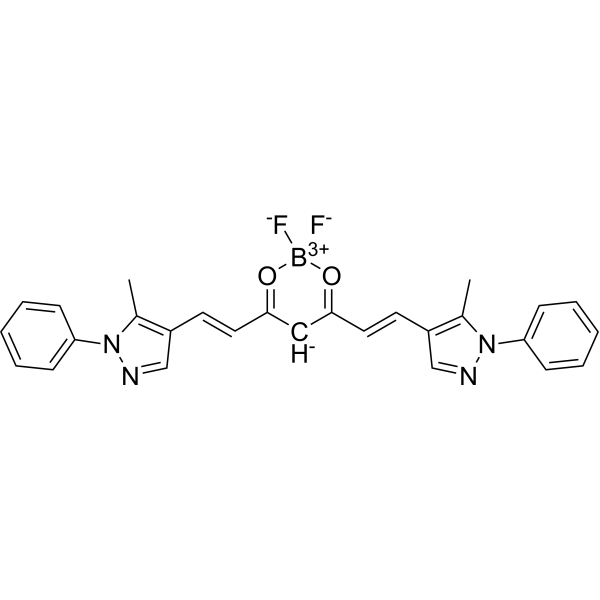
-
- HY-P990078
-
|
LY3372993
|
Amyloid-β
|
Neurological Disease
|
|
Remternetug is a human immunoglobulin G1-kappa, anti-APP (amyloid beta A4 precursor protein) Aβ42 N3pGlu peptide monoclonal antibody. Remternetug recognizes a pyroglutamated form of Aβ that aggregates into amyloid plaques .
|
-

-
- HY-P1468
-
|
amyloid β-Protein (1-28)
|
Amyloid-β
|
Neurological Disease
|
|
β-Amyloid (1-28) is a β-Amyloid protein fragment involved in metal binding. Beta-amyloid is a peptide that forms amyloid plaques in the brains of Alzheimer's disease (AD) patients.
|
-

-
- HY-149219
-
|
|
Amyloid-β
|
Neurological Disease
|
|
BIBD-124 binds amyloid beta (Aβ) plaque with an IC50 value of 9.51 nM. [18F]BIBD-124 can be used as radiotracer of Aβ plaques .
|
-

-
- HY-P1567
-
|
|
Amyloid-β
|
Neurological Disease
|
|
β-Amyloid (10-35), amide is composed of 26 aa (10-35 residues of the Aβ peptide) and is the primary component of the amyloid plaques of Alzheimer’s disease.
|
-

-
- HY-P0265
-
-

-
- HY-P2562
-
|
|
Amyloid-β
|
Neurological Disease
|
|
β-Amyloid (1-38), mouse, rat is composed of 38 aa (1-38 residues of the Aβ peptide) and is the primary component of the amyloid plaques of Alzheimer’s disease .
|
-
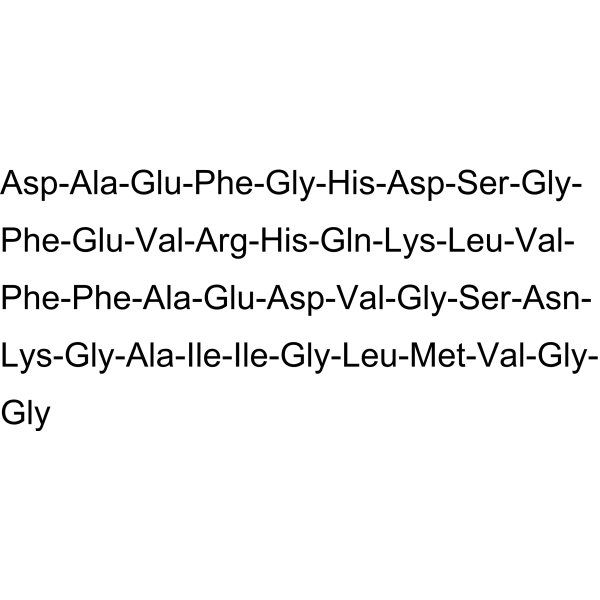
-
- HY-103240
-
|
|
Amyloid-β
|
Others
|
|
Methoxy-X04 is a fluorescent dye that crosses the blood-brain barrier and selectively binds to beta-pleated sheets found in dense core amyloid Aβ plaques. Methoxy-X04 retains in vitro binding affinity for amyloid b (Ab) fibrils (Ki= 26.8 nM). Methoxy-X04 is fluorescent and stains plaques, tangles, and cerebrovascular amyloid in postmortem sections of AD brain with good specificity .
|
-
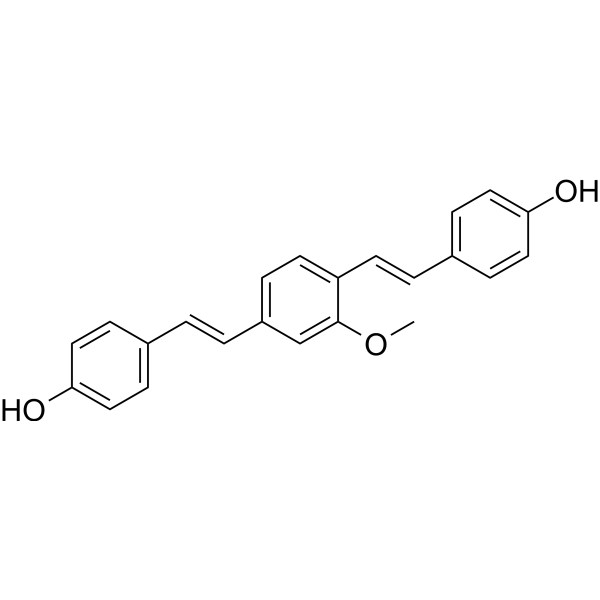
-
- HY-P0265A
-
|
amyloid Beta-Peptide (1-40) (human) TFA; amyloid β-Peptide (1-40) (human) TFA
|
Amyloid-β
|
Neurological Disease
|
|
β-Amyloid (1-40) TFA is a primary protein in plaques found in the brains of patients with Alzheimer's disease .
|
-

-
- HY-139516
-
|
AZ13040214; NAV4614
|
Amyloid-β
|
Others
|
|
AZD4694 Precursor (AZ13040214) is the precursor of [ 18F] AZD4694 for the synthesis of [ 18F] AZD4694, an amyloid-β imaging ligand with high affinity for amyloid-β plaques .
|
-

-
- HY-P0265AS
-
|
amyloid Beta-Peptide-15N (1-40) (human) TFA; amyloid β-Peptide-15N (1-40) (human) TFA
|
Amyloid-β
|
Neurological Disease
|
|
β-Amyloid- 15N (1-40) (TFA) is the 15N-labledβ-Amyloid (1-40) (TFA). β-Amyloid (1-40) is a primary protein in plaques found in the brains of patients with Alzheimer's disease[1].
|
-
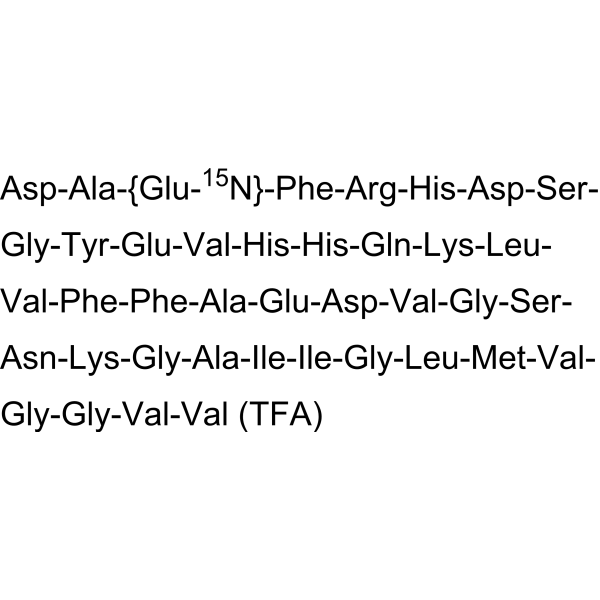
-
- HY-W010041
-
|
|
Amyloid-β
Endogenous Metabolite
|
Neurological Disease
|
|
Scyllo-Inositol, an amyloid inhibitor, potentialy inhibits α-synuclein aggregation. Scyllo-Inositol stabilizes a non-fibrillar non-toxic form of amyloid-β peptide (Aβ42) in vitro, reverses cognitive deficits, and reduces synaptic toxicity and lowers amyloid plaques in an Alzheimer's disease mouse model .
|
-
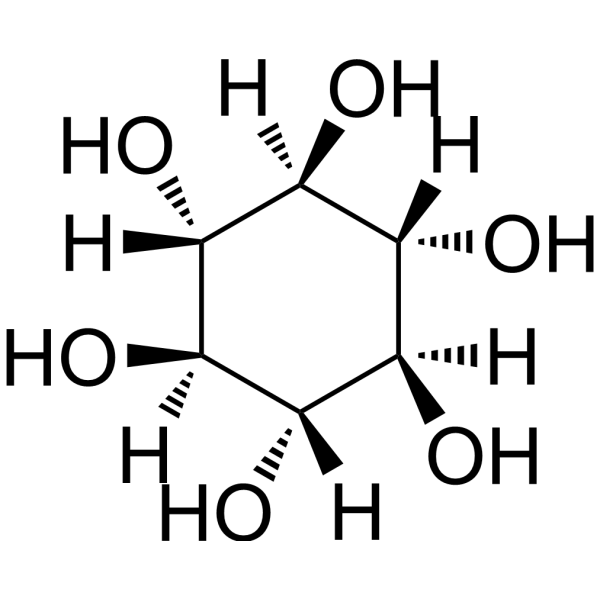
-
- HY-P3779
-
|
Aβ(17-42)
|
Apoptosis
|
Neurological Disease
|
|
Amyloid 17-42 (Aβ(17-42)) is a major constituent of diffuse plaques in Alzheimer's disease and cerebellar pre-amyloid in Down's syndrome, derived by alpha- and gamma-secretase cleavage of the amyloid precursor protein (APP). Amyloid 17-42 can induce neuronal apoptosis via a Fas-like/caspase-8 activation pathway .
|
-

-
- HY-113938
-
|
NAV4694
|
Amyloid-β
|
Cardiovascular Disease
|
|
AZD4694 (NAV4694), a fluorinated β-amyloid (Aβ) plaque neuroimaging PET radioligand, shows high affinity for Aβ fibrils (Kd = 2.3 nM) .
|
-
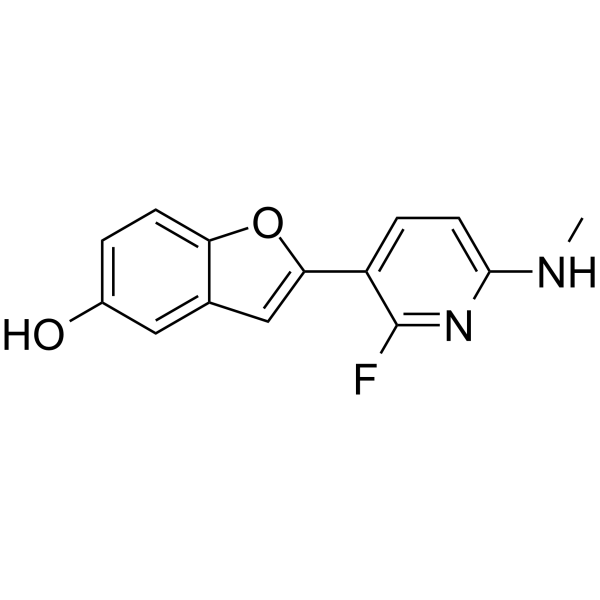
-
- HY-P3780
-
|
|
Amyloid-β
|
Neurological Disease
|
|
Cys-Gly-Lys-Lys-Gly-Amyloid β-Protein (36-42) is the 36-42 fragment of Amyloid β-Protein. β-amyloid, a polypeptide made up of 36-43 amino acids, is the main component of amyloid plaques found in the brains of people with Alzheimer's disease. β-amyloid oligomers (Aβos) plays A key role in the progression of Alzheimer's disease (AD) by inducing neuronal damage and cognitive impairment .
|
-

-
- HY-P1051
-
|
amyloid β-Protein (12-28)
|
Amyloid-β
|
Neurological Disease
|
|
β-Amyloid (12-28) (Amyloid β-Protein (12-28)) is a peptide fragment of β-amyloid protein (β1-42). β1-42, a 42 amino acid protein , is the major component of senile plaque cores. β-Amyloid (12-28) shows aggregation properties. β-Amyloid (12-28) has the potential for Alzheimer’s disease research .
|
-

-
- HY-P1051A
-
|
amyloid β-Protein (12-28) (TFA); amyloid Beta-Peptide (12-28) (human) TFA; β-amyloid protein fragment(12-28) TFA
|
Amyloid-β
|
Neurological Disease
|
|
β-Amyloid (12-28) (TFA) (Amyloid β-Protein (12-28) (TFA)) is a peptide fragment of β-amyloid protein (β1-42). β1-42, a 42 amino acid protein , is the major component of senile plaque cores. β-Amyloid (12-28) (TFA) shows aggregation properties. β-Amyloid (12-28) (TFA) has the potential for Alzheimer’s disease research .
|
-

-
- HY-P1387
-
|
|
Amyloid-β
Apoptosis
|
Neurological Disease
|
|
β-Amyloid (1-40) (rat) is a rat form of the amyloid β-peptide, which accumulates as an insoluble extracellular deposit around neurons, giving rise to the senile plaques associated with Alzheimer's disease (AD). β-Amyloid (1-40) (rat) increases 45Ca 2+ influx, induces neurodegeneration in the rat hippocampal neurons of the CA1 subfield. β-Amyloid (1-40) (rat) induces apoptosis. β-Amyloid (1-40) (rat) can be used for the research of Alzheimer's disease .
|
-

-
- HY-D1684
-
|
|
Amyloid-β
|
Neurological Disease
|
|
DCDAPH (Compound 2c) is a novel smart NIRF probe for detection of β-amyloid (Aβ) plaques (λex/λem=597/665 nm in PBS). DCDAPH shows high affinity for Aβ aggregates (Ki=37 nM, Kd=27 nM). DCDAPH shows good blood brain barrier permeation and can meet most of the requirements for the detection of Aβ plaques both in vitro and in vivo .
|
-
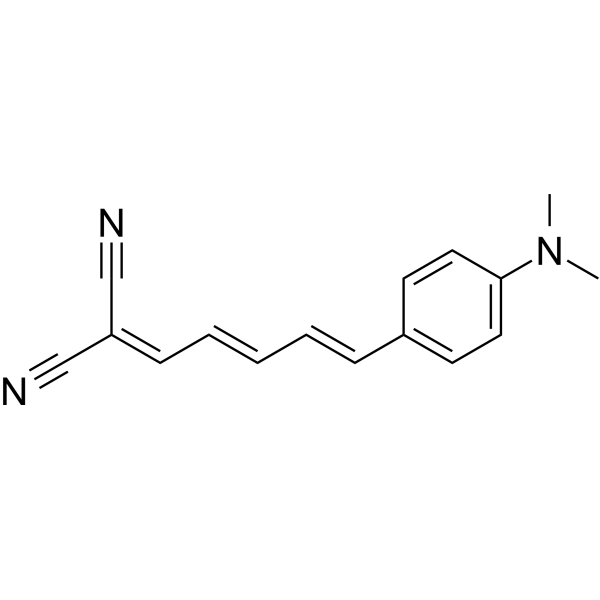
-
- HY-103373
-
|
|
Cholinesterase (ChE)
|
Neurological Disease
|
|
PE154 (Compound 13) is a potent fluorescent inhibitor of human acetylcholinesterase (AChE) and butyrylcholinesterase (BChE) (IC50s=280 pM and 16 nM, respectively) . PE154 can label β-amyloid plaques in histochemical analysis .
|
-
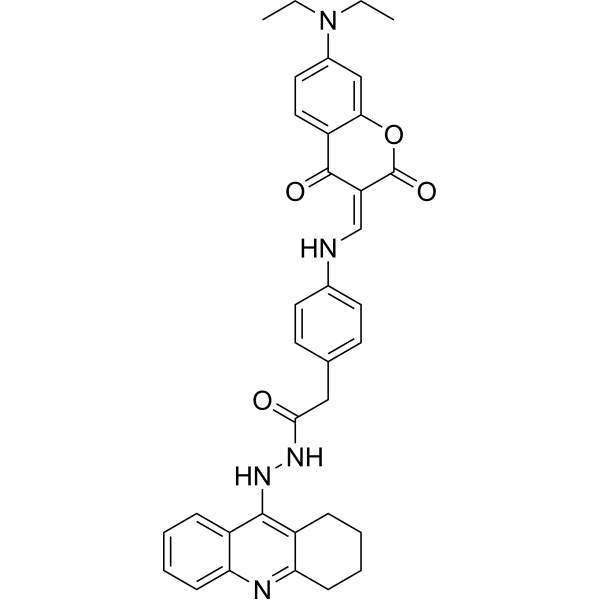
-
- HY-125962
-
|
|
Fluorescent Dye
Amyloid-β
|
Neurological Disease
|
|
X-34 is a lipophilic and bright yellow-green fluorescent derivative of Congo red (HY-D0236). X-34 can be used to stain neuritic and diffuse plaques, neurofibrillary tangles (NFTs), neuropil threads, and cerebrovascular amyloid in the brain. X-34 can be used for research of Alzheimer’s disease .
|
-
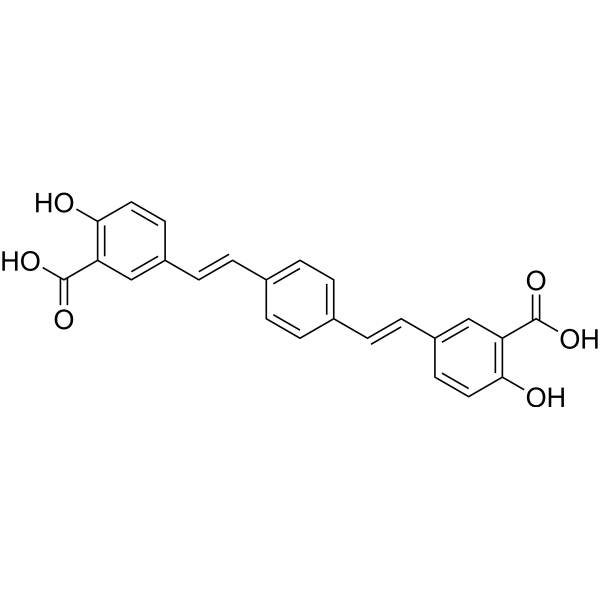
-
- HY-120597
-
|
|
Calcium Channel
|
Neurological Disease
|
|
SAK3 is a potent T-type voltage-gated Ca 2+ channels (T-VGCCs) enhancer. SAK3 enhances Cav3.1 and Cav3.3 T-type Ca 2+ channel currents. Acute SAK3 administration improves memory deficits in olfactory-bulbectomized mice . SAK3 inhibits amyloid β plaque formation in APP-KI mice by activating the proteasome activity .
|
-
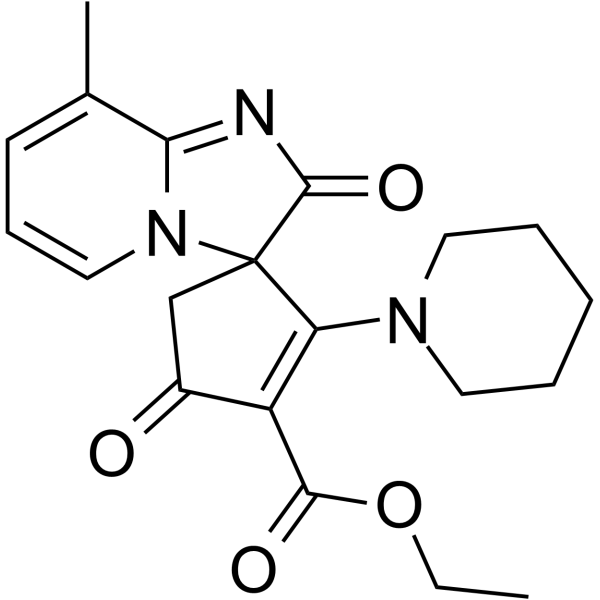
-
- HY-152110
-
|
|
Cholinesterase (ChE)
Monoamine Oxidase
|
Neurological Disease
|
|
Dual AChE-MAO B-IN-5, indanone derivative, is a potent dual AChE/MAO-B inhibitior with IC50 values of 0.0224, 0.0412, and 0.1116 μM for AChE, MAO-B and MAO-A, respectively. Dual AChE-MAO B-IN-5 has antioxidant activity and prevents β-amyloid plaque aggregation. Dual AChE-MAO B-IN-5 can be used for Alzheimer’s disease (AD) research .
|
-
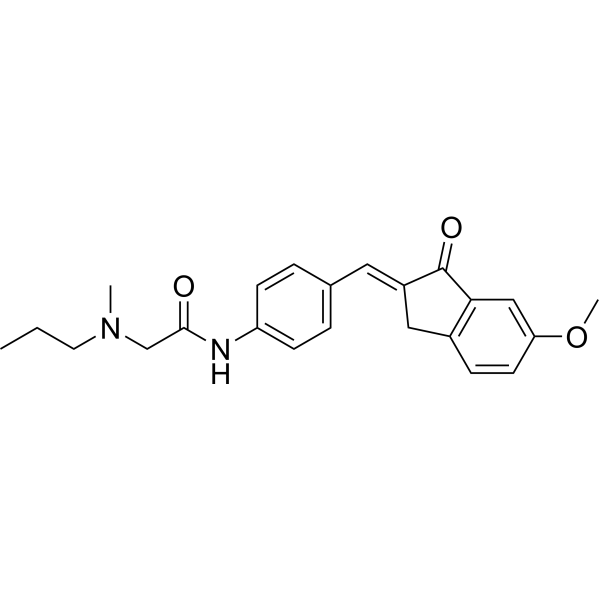
-
- HY-P1047
-
|
[Pro18, Asp21] β-amyloid (17-21)
|
Amyloid-β
|
Neurological Disease
|
|
β-Sheet Breaker Peptide iAβ5 is a potent degrader of cerebral amyloid-beta (Abeta). Abeta deposition is associatied with the Alzheimer disease (AD), due to its related toxicity linked to its beta-sheet conformation and/or aggregation. β-Sheet Breaker Peptide iAβ5 reproducibly induces in vivo disassembly of fibrillar amyloid deposits. Thus, β-Sheet Breaker Peptide iAβ5 prevents and/or reverses neuronal shrinkage caused by Abeta, and reduces the extent of interleukin-1beta positive microglia-like cells that surround the Abeta deposits. β-Sheet Breaker Peptide iAβ5 reduces the size and/or number of cerebral amyloid plaques in AD. β-Sheet Breaker Peptide iAβ5 labeled by hydrophobic benzyl alcohol (HBA) tag, can be used for quantitative assay by showing vivid blue color under acidic conditions .
|
-
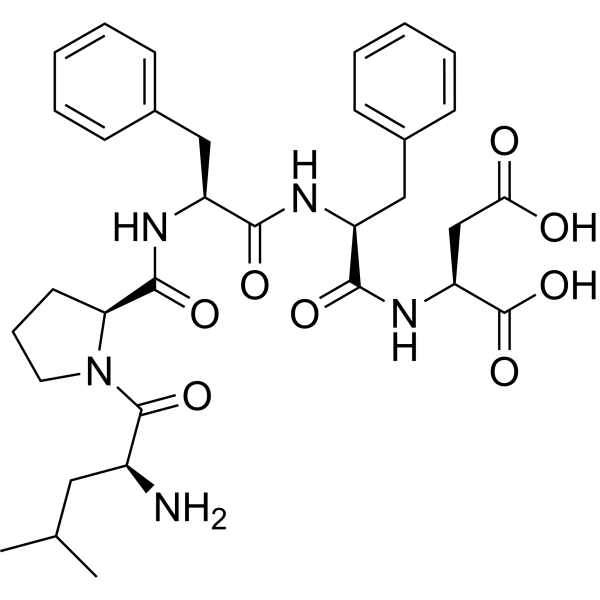
-
- HY-152114
-
|
|
Monoamine Oxidase
Cholinesterase (ChE)
|
Neurological Disease
|
|
AChE/BChE/MAO-B-IN-4, an indan-1-one derivative, is a potent MAO-B inhibitor with an IC50 of 0.0393 μM for human MAO-B. AChE/BChE/MAO-B-IN-4 is a potent AChE and BChE enzyme inhibitor, with IC50s of 0.0458 μM and 0.075 μM for human AChE and BChE enzyme, respectively. AChE/BChE/MAO-B-IN-4 shows significant antioxidant activity and prevent β-amyloid plaque aggregation. AChE/BChE/MAO-B-IN-4 has the potential for Alzheimer's disease (AD) research .
|
-
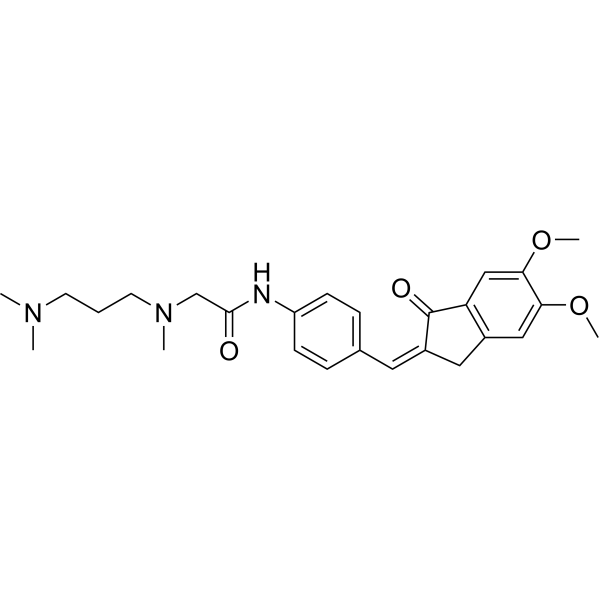
-
- HY-100604
-
|
|
γ-secretase
Amyloid-β
|
Neurological Disease
|
|
JNJ-40418677 is an orally active modulator of γ-secretase, can cross the blood-brain barrier. JNJ-40418677 inhibits Aβ42 and NS2B-NS3 protease, with IC50s of 200 nM and 3.9 μM, respectively. JNJ-40418677 displays good biological tolerance, can be use for Alzheimer’s disease research .
|
-
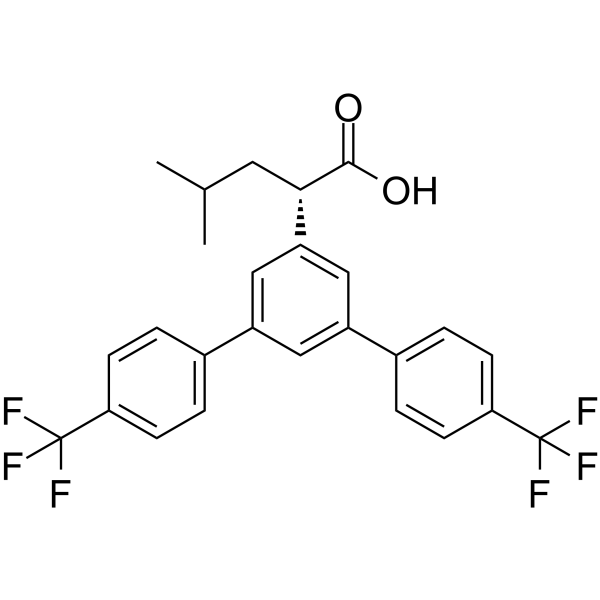
| Cat. No. |
Product Name |
Type |
-
- HY-103240
-
|
|
Dyes
|
|
Methoxy-X04 is a fluorescent dye that crosses the blood-brain barrier and selectively binds to beta-pleated sheets found in dense core amyloid Aβ plaques. Methoxy-X04 retains in vitro binding affinity for amyloid b (Ab) fibrils (Ki= 26.8 nM). Methoxy-X04 is fluorescent and stains plaques, tangles, and cerebrovascular amyloid in postmortem sections of AD brain with good specificity .
|
-
- HY-103373
-
|
|
Fluorescent Dyes/Probes
|
|
PE154 (Compound 13) is a potent fluorescent inhibitor of human acetylcholinesterase (AChE) and butyrylcholinesterase (BChE) (IC50s=280 pM and 16 nM, respectively) . PE154 can label β-amyloid plaques in histochemical analysis .
|
-
- HY-D1684
-
|
|
Fluorescent Dyes/Probes
|
|
DCDAPH (Compound 2c) is a novel smart NIRF probe for detection of β-amyloid (Aβ) plaques (λex/λem=597/665 nm in PBS). DCDAPH shows high affinity for Aβ aggregates (Ki=37 nM, Kd=27 nM). DCDAPH shows good blood brain barrier permeation and can meet most of the requirements for the detection of Aβ plaques both in vitro and in vivo .
|
| Cat. No. |
Product Name |
Target |
Research Area |
-
- HY-P1046
-
|
amyloid β-Protein (1-15)
|
Amyloid-β
|
Neurological Disease
|
|
β-Amyloid (1-15) is a fragment of β-Amyloid peptide. Beta-amyloid is a peptide that forms amyloid plaques in the brains of Alzheimer's disease (AD) patients.
|
-
- HY-P1466
-
|
amyloid β-Protein (1-16)
|
Amyloid-β
|
Neurological Disease
|
|
β-Amyloid (1-16) is a β-Amyloid protein fragment involved in metal binding. Beta-amyloid is a peptide that forms amyloid plaques in the brains of Alzheimer's disease (AD) patients.
|
-
- HY-P1468
-
|
amyloid β-Protein (1-28)
|
Amyloid-β
|
Neurological Disease
|
|
β-Amyloid (1-28) is a β-Amyloid protein fragment involved in metal binding. Beta-amyloid is a peptide that forms amyloid plaques in the brains of Alzheimer's disease (AD) patients.
|
-
- HY-P1567
-
|
|
Amyloid-β
|
Neurological Disease
|
|
β-Amyloid (10-35), amide is composed of 26 aa (10-35 residues of the Aβ peptide) and is the primary component of the amyloid plaques of Alzheimer’s disease.
|
-
- HY-P0265
-
-
- HY-P2562
-
|
|
Amyloid-β
|
Neurological Disease
|
|
β-Amyloid (1-38), mouse, rat is composed of 38 aa (1-38 residues of the Aβ peptide) and is the primary component of the amyloid plaques of Alzheimer’s disease .
|
-
- HY-P0265A
-
|
amyloid Beta-Peptide (1-40) (human) TFA; amyloid β-Peptide (1-40) (human) TFA
|
Amyloid-β
|
Neurological Disease
|
|
β-Amyloid (1-40) TFA is a primary protein in plaques found in the brains of patients with Alzheimer's disease .
|
-
- HY-P0265AS
-
|
amyloid Beta-Peptide-15N (1-40) (human) TFA; amyloid β-Peptide-15N (1-40) (human) TFA
|
Amyloid-β
|
Neurological Disease
|
|
β-Amyloid- 15N (1-40) (TFA) is the 15N-labledβ-Amyloid (1-40) (TFA). β-Amyloid (1-40) is a primary protein in plaques found in the brains of patients with Alzheimer's disease[1].
|
-
- HY-P3779
-
|
Aβ(17-42)
|
Apoptosis
|
Neurological Disease
|
|
Amyloid 17-42 (Aβ(17-42)) is a major constituent of diffuse plaques in Alzheimer's disease and cerebellar pre-amyloid in Down's syndrome, derived by alpha- and gamma-secretase cleavage of the amyloid precursor protein (APP). Amyloid 17-42 can induce neuronal apoptosis via a Fas-like/caspase-8 activation pathway .
|
-
- HY-P3780
-
|
|
Amyloid-β
|
Neurological Disease
|
|
Cys-Gly-Lys-Lys-Gly-Amyloid β-Protein (36-42) is the 36-42 fragment of Amyloid β-Protein. β-amyloid, a polypeptide made up of 36-43 amino acids, is the main component of amyloid plaques found in the brains of people with Alzheimer's disease. β-amyloid oligomers (Aβos) plays A key role in the progression of Alzheimer's disease (AD) by inducing neuronal damage and cognitive impairment .
|
-
- HY-P1051
-
|
amyloid β-Protein (12-28)
|
Amyloid-β
|
Neurological Disease
|
|
β-Amyloid (12-28) (Amyloid β-Protein (12-28)) is a peptide fragment of β-amyloid protein (β1-42). β1-42, a 42 amino acid protein , is the major component of senile plaque cores. β-Amyloid (12-28) shows aggregation properties. β-Amyloid (12-28) has the potential for Alzheimer’s disease research .
|
-
- HY-P1051A
-
|
amyloid β-Protein (12-28) (TFA); amyloid Beta-Peptide (12-28) (human) TFA; β-amyloid protein fragment(12-28) TFA
|
Amyloid-β
|
Neurological Disease
|
|
β-Amyloid (12-28) (TFA) (Amyloid β-Protein (12-28) (TFA)) is a peptide fragment of β-amyloid protein (β1-42). β1-42, a 42 amino acid protein , is the major component of senile plaque cores. β-Amyloid (12-28) (TFA) shows aggregation properties. β-Amyloid (12-28) (TFA) has the potential for Alzheimer’s disease research .
|
-
- HY-P1387
-
|
|
Amyloid-β
Apoptosis
|
Neurological Disease
|
|
β-Amyloid (1-40) (rat) is a rat form of the amyloid β-peptide, which accumulates as an insoluble extracellular deposit around neurons, giving rise to the senile plaques associated with Alzheimer's disease (AD). β-Amyloid (1-40) (rat) increases 45Ca 2+ influx, induces neurodegeneration in the rat hippocampal neurons of the CA1 subfield. β-Amyloid (1-40) (rat) induces apoptosis. β-Amyloid (1-40) (rat) can be used for the research of Alzheimer's disease .
|
-
- HY-P1047
-
|
[Pro18, Asp21] β-amyloid (17-21)
|
Amyloid-β
|
Neurological Disease
|
|
β-Sheet Breaker Peptide iAβ5 is a potent degrader of cerebral amyloid-beta (Abeta). Abeta deposition is associatied with the Alzheimer disease (AD), due to its related toxicity linked to its beta-sheet conformation and/or aggregation. β-Sheet Breaker Peptide iAβ5 reproducibly induces in vivo disassembly of fibrillar amyloid deposits. Thus, β-Sheet Breaker Peptide iAβ5 prevents and/or reverses neuronal shrinkage caused by Abeta, and reduces the extent of interleukin-1beta positive microglia-like cells that surround the Abeta deposits. β-Sheet Breaker Peptide iAβ5 reduces the size and/or number of cerebral amyloid plaques in AD. β-Sheet Breaker Peptide iAβ5 labeled by hydrophobic benzyl alcohol (HBA) tag, can be used for quantitative assay by showing vivid blue color under acidic conditions .
|
| Cat. No. |
Product Name |
Target |
Research Area |
-
- HY-P990078
-
|
LY3372993
|
Amyloid-β
|
Neurological Disease
|
|
Remternetug is a human immunoglobulin G1-kappa, anti-APP (amyloid beta A4 precursor protein) Aβ42 N3pGlu peptide monoclonal antibody. Remternetug recognizes a pyroglutamated form of Aβ that aggregates into amyloid plaques .
|
| Cat. No. |
Product Name |
Category |
Target |
Chemical Structure |
| Cat. No. |
Product Name |
Chemical Structure |
-
- HY-P0265AS
-
|
|
|
β-Amyloid- 15N (1-40) (TFA) is the 15N-labledβ-Amyloid (1-40) (TFA). β-Amyloid (1-40) is a primary protein in plaques found in the brains of patients with Alzheimer's disease[1].
|
-

Your information is safe with us. * Required Fields.
Inquiry Information
- Product Name:
- Cat. No.:
- Quantity:
- MCE Japan Authorized Agent:




































